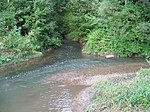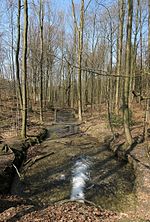Hermannsdenkmal

The Hermannsdenkmal (German for "Hermann Monument") is a monument located southwest of Detmold in the district of Lippe (North Rhine-Westphalia), in Germany. It stands on the densely forested Grotenburg, sometimes also called the Teutberg or Teut, a hill (elevation 386 m) in the Teutoburger Wald (Teutoburg Forest) range. The monument is located inside the remains of a circular rampart. The monument was constructed between 1838 and 1875 to commemorate the Cherusci war chief Arminius (in German, Hermann) and his victory over Rome at the Battle of the Teutoburg Forest in 9 AD. When the statue was built, its location was believed to be near the original battle site, although experts now consider it more likely that the battle took place near Kalkriese, about 100 km to the north-west.
Excerpt from the Wikipedia article Hermannsdenkmal (License: CC BY-SA 3.0, Authors, Images).Hermannsdenkmal
Grotenburg,
Geographical coordinates (GPS) Address Nearby Places Show on map
Geographical coordinates (GPS)
| Latitude | Longitude |
|---|---|
| N 51.911666666667 ° | E 8.8394444444444 ° |
Address
Grotenburg
Grotenburg
32760 , Hiddesen
North Rhine-Westphalia, Germany
Open on Google Maps









